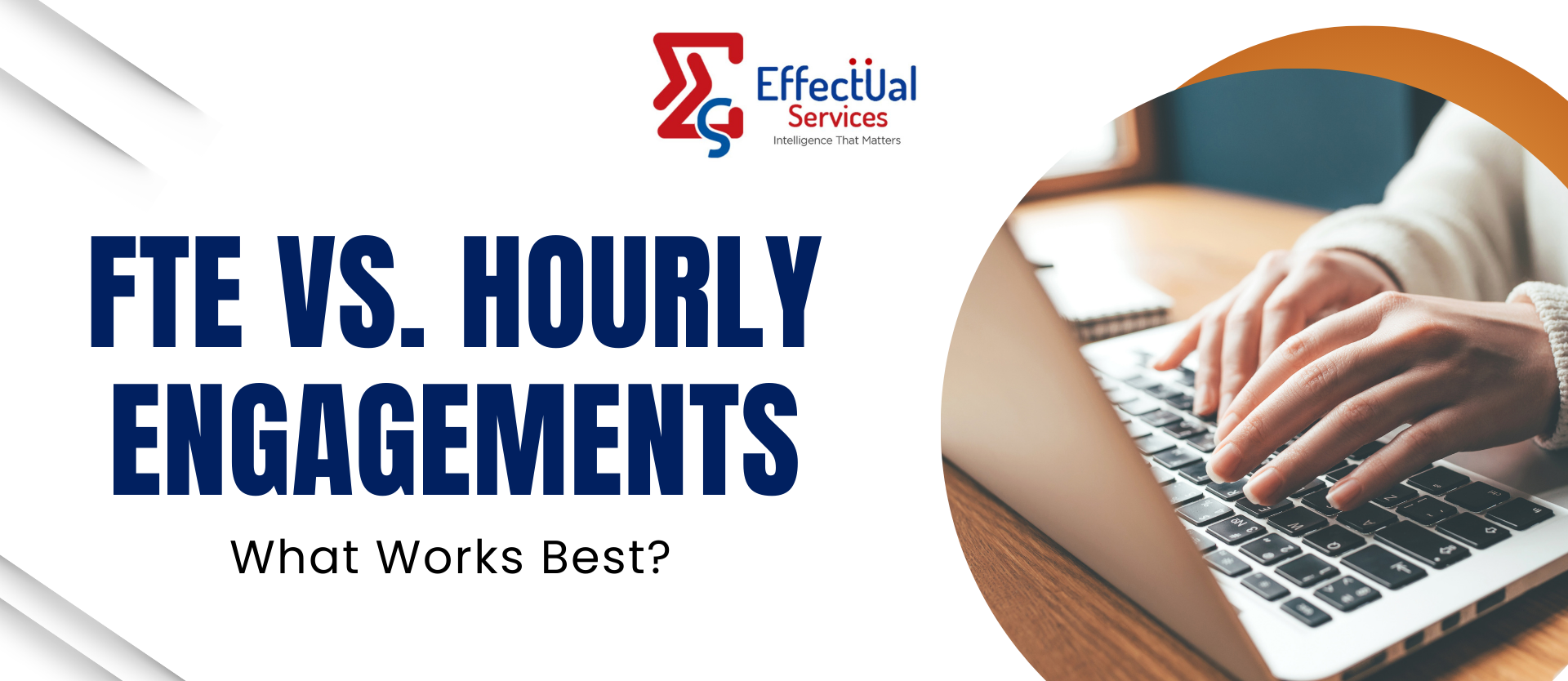FTE vs. Hourly Engagements: What Works Best?

How do Their Work and Why Recruiting Style Counts More Than You Believe?
What is often neglected in IP firms is not the filings or the litigation strategy, which are more visible. Instead, it has to do with how the personnel carrying out the work are hired. This behind-the-scenes protocol has a big impact on the operational effectiveness of the firm, the clients' perception, and service delivery.
Historically, by and large, IP firms have opted to go with full-time individuals either retained directly or on long retainers. Made sense. They're always present, they know how the firm does things, and it's consistent. But it's changing. Quickly. Particularly post-pandemic, firms realize value in having something flexible bring in people on a needs basis. The concept of hourly-based is now receiving consideration in areas where it wasn't considered at all in the past.
So what is best? Full-time employment or hiring on an hour basis?
Let us refrain from hastiness. First, let us analyze what these two terms signify and how they manifest in a typical intellectual property firm.
Full-time individual (or FTE, if you prefer the big word) is an individual who is present each and every day. Perhaps not technically as an employee but an individual who is a stalwart in your team. They are familiar with how your docketing is done, how to deal with an eccentric client's likes and dislikes, how to troubleshoot the PTO site being down at 11 p.m. In short, they've been through the mill with you.
This setup is brilliant if your firm handles steady volumes like continuous patent prosecution or long-term trademark portfolios. It means less explaining, less on boarding, fewer hiccups. Over time, this person becomes a knowledge asset.
But things don’t always stay steady. Some weeks your neck-deep in filings, others are slow. Maybe you suddenly land a project in a new tech domain that no one internally knows enough about. That’s where the hourly model comes in.
With an hour-to-hour engagement, long-term anything is not on the table. You bring in the experts when you've got a certain job to do and pay only for what's done. Need a person to just do one week? Great. No forms to be filled out, no pulling someone on to the payroll. Quick and it exposes you to worldwide talent.
Companies with non-core tech areas tend to be hybrid. They maintain a tight, thin in-house staff core to manage the routine work. Then, they have a pool of experts to bring in when it's specific, urgent, or tough.
This hybrid approach is booming rapidly. No longer is it just a contingency plan; instead, it is fast becoming the norm of savvy organizations wanting to be efficient and competent.
There is no standard. For a company doing ordinary patent prosecution, FTEs may be perfect. But if it is doing one-off competitive analysis projects or litigation support, then maybe going by the hour will avoid both time and money.
Let’s not forget another angle client are changing too. Many now ask for transparency in billing, demand flexibility, and want you to scale fast when their needs grow. If your hiring model can’t support that, you’ll lose business.
Tech platforms are changing things too. Remote collaboration software, communal IP dashboards, cloud-based prosecution workflows these all make it a lot easier to collaborate with somebody half way around the globe. So the former geographical and availability barriers are dissolving.
In the fast-evolving world of intellectual property (IP), law firms and service providers are constantly in pursuit of the best efficient and economical ways to deliver high-caliber output. Two key engagement forms having become prevalent in this space are Full-Time Equivalent (FTE) and hour-based engagements. There are certain pros and cons associated with each form in terms of operational strategy, consistency in workload, and budgetary parameters of the firm. Hence, is either form the best suited for IP firms? The answer to this question depends on certain overriding factors.
Understanding the Models
Full-Time Equivalent (FTE) Model
Under this FTE mode, the client is committing an amount of full-time resources on a specified term on an annually or monthly basis.
These resources carry out the client assignments wholly or largely and integration is fostered as an expansion to internal teams.
Hourly Engagement Model
Under this system, payment is made in proportion to the time it takes to carry out assignments. The system is very versatile and allows very easy up- or down-scaling of services whenever needed, other than accepting long term contracts.
Pros and Cons
1. Cost Predictability and Control
FTE: Budgeting is bound to be less volatile and a definite monthly expense is conveyed to customers, regardless of volume swings.
Hourly arrangements are highlighted with increased flexibility to variable amounts of workload; however, the budget has lessened predictability. Cost escalation is likely in instances of surges in demand. The Full-Time Equivalent (FTE) system is deemed best adapted to organizations within stable levels of workload.
Hourly charges are deemed more suitable in firms whose demand is subject to fluctuation.
2. Operational Flexibility
FTE: There is limited flexibility.
Where the workload is curbed, payback on idle assets may even be mandated.
Hourly: Hourly arrangements afford a high level of flexibility. Payment depends entirely on the actual time worked and so makes this model very well suited to short-term or one-off requirements. The hour structure is deemed best suited to organizations having an immediate or specialized needs in operation.
3. Team Integration and Quality
FTE: The full-time equivalent (FTE) enables increased alignment of external groups with internal procedures. Consequently, this facilitates increased alignment, greater quality control, and greater institutional knowledge.
Hourly: Support is usually provided on an hourly basis by on-demand teams or rotating staff, a system that might bring about low continuity and a steeper learning curve. Where continuity and specialized knowledge are critically essential, full-time staff (FTE) are preferred.
4. Scalability
FTE: Scaling a highly efficient team may involve a longer ramp-up period and extensive planning.
Hourly: Hourly arrangements facilitate easier and quicker scaling, particularly for urgent or high-volume projects.
Hourly is recognized to be the most effective option if immediate scalability is needed.
Key Use Cases
When FTE Is Chosen:
- Big patent portfolios or stream of prosecution work are usually handled by this model.
- Patent drafting, docketing, or paralegal services tend to be outsourced in FTE transactions.
- Long-term co-operative strategies will be forged by frequent and sustained contributions.
When Hourly Is Preferred:
- Freedom-to-operate (FTO) searches, prior art reviews, and project-based litigation support are managed with greater flexibility. Recent vendors or processes are sometimes evaluated through hourly engagements.
- During the hours of peak usage, overflow is managed well through on-demand resources.
Hybrid Models: The Best of Both Worlds?
One such trend is an imminent hybrid model being increasingly accepted in IP firms. Stability in core activities through FTEs is now being supported by hour resources to manage overflow or to acquire niche skills. This approach achieves cost-effectiveness without the compromise of agility.
Conclusion
It should be noted here that a one-size-fits-all solution cannot be applied everywhere. The selection of the best possible engagement model depends on the specific needs, budget confi ns, and strategic objectives of each respective individual intellectual property firm. Full-Time Equivalent (FTE) agreement is warranted if long-term collaboration, continuity of operations, and stable expenses are a priority. An hourly agreement is otherwise typically chosen if flexibility, reactivity, and pay-as-they-use convenience are important. Long term, the optimum value is achieved when an individualized approach is used—one in which strengths of both strategies are leveled and leveraged by forward-looking intellectual property firms.
Related Resources:
The Rise of Remote IP Operations: FTE Models Reshaping Legal Delivery
The Strategic Edge: Building Niche IP Teams Through the FTE Model
Solutions Driving Innovation & Intelligence
Enabling Fortune 500's, R&D Giants, Law firms, Universities, Research institutes & SME's Around The Globe Gather Intelligence That
Protects and Nurtures Innovation Through a Team of 250+ Techno Legal Professionals.

